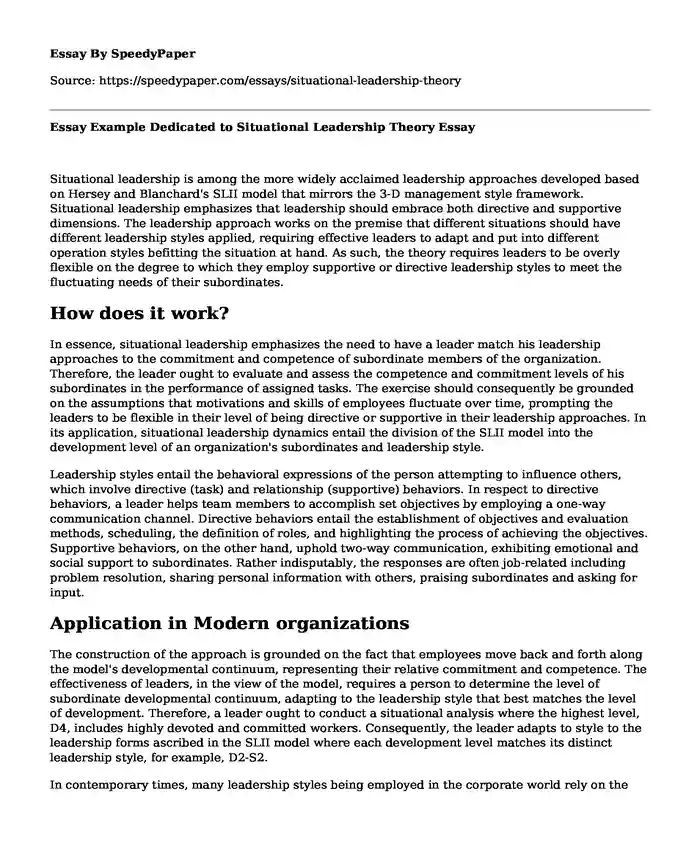
| Type of paper: | Essay |
| Categories: | Leadership style |
| Pages: | 3 |
| Wordcount: | 713 words |
Situational leadership is among the more widely acclaimed leadership approaches developed based on Hersey and Blanchard's SLII model that mirrors the 3-D management style framework. Situational leadership emphasizes that leadership should embrace both directive and supportive dimensions. The leadership approach works on the premise that different situations should have different leadership styles applied, requiring effective leaders to adapt and put into different operation styles befitting the situation at hand. As such, the theory requires leaders to be overly flexible on the degree to which they employ supportive or directive leadership styles to meet the fluctuating needs of their subordinates.
How does it work?
In essence, situational leadership emphasizes the need to have a leader match his leadership approaches to the commitment and competence of subordinate members of the organization. Therefore, the leader ought to evaluate and assess the competence and commitment levels of his subordinates in the performance of assigned tasks. The exercise should consequently be grounded on the assumptions that motivations and skills of employees fluctuate over time, prompting the leaders to be flexible in their level of being directive or supportive in their leadership approaches. In its application, situational leadership dynamics entail the division of the SLII model into the development level of an organization's subordinates and leadership style.
Leadership styles entail the behavioral expressions of the person attempting to influence others, which involve directive (task) and relationship (supportive) behaviors. In respect to directive behaviors, a leader helps team members to accomplish set objectives by employing a one-way communication channel. Directive behaviors entail the establishment of objectives and evaluation methods, scheduling, the definition of roles, and highlighting the process of achieving the objectives. Supportive behaviors, on the other hand, uphold two-way communication, exhibiting emotional and social support to subordinates. Rather indisputably, the responses are often job-related including problem resolution, sharing personal information with others, praising subordinates and asking for input.
Application in Modern organizations
The construction of the approach is grounded on the fact that employees move back and forth along the model's developmental continuum, representing their relative commitment and competence. The effectiveness of leaders, in the view of the model, requires a person to determine the level of subordinate developmental continuum, adapting to the leadership style that best matches the level of development. Therefore, a leader ought to conduct a situational analysis where the highest level, D4, includes highly devoted and committed workers. Consequently, the leader adapts to style to the leadership forms ascribed in the SLII model where each development level matches its distinct leadership style, for example, D2-S2.
In contemporary times, many leadership styles being employed in the corporate world rely on the fundamentals of situational leadership. It remains the most popular leadership style in organizations, with most leaders making attempts towards understanding their approaches in the context of the people and task involved to ensure that the best leadership approach is applied to befit specific situations.
Strengths and weaknesses of situational leadership
The approach has several strengths that mostly apply to practitioners. First, the method has been employed in the marketplace for a long time now in training leaders and has a high approval rating amongst corporate leaders who perceive the model as a credible and reliable approach in the creation of effective leaders. Secondly, the method is lauded for its practicality, intuitive sensibility, and easy application in varied settings. The third strength is its prescriptive value, directing leaders on what to do and not do in various contextual situations. Lastly, the approach emphasizes leader flexibility, compelling leaders to adapt to the needs of their subordinates and the task at hand to achieve organizational goals.
Despite the expansive employment of the approach in many organizations, situational leadership theory has some weaknesses that provide a more balanced insight into its applicability to leadership. Prevalent among the weakness is the fact that little research has been conducted to establish and unravel evidence-based facts to support the assumptions outlined herein. In addition, the ambiguous presentation of the relationship between workers' commitment and competence to constitute the four development levels of the SLII model (D1,2,3 &4). Lastly, the available evidence falls short of credible explanations justifying the model's argument that matches the leadership style of a given person with the development levels of the subordinate members of an organization.
Cite this page
Essay Example Dedicated to Situational Leadership Theory. (2022, Jul 07). Retrieved from https://speedypaper.com/essays/situational-leadership-theory
Request Removal
If you are the original author of this essay and no longer wish to have it published on the SpeedyPaper website, please click below to request its removal:
- Small Group Functioning - Free Essay on Teamwork
- Free Essay Example: Administrative Policy for Tesla, Inc. Consulting Letter
- Statistics Essay Example on the Application of the Regression Model
- Wearable Computing and Ubiquitous Computing Augmented Fashion, Smart Textiles and IoT Augmenting Humans
- Research Paper Sample on Rebecca Solnit's Essays
- China's Consumer Attitudes
- What was the nature of the split between the Helpers and the Emigrants after the Prophet's death?
Popular categories




